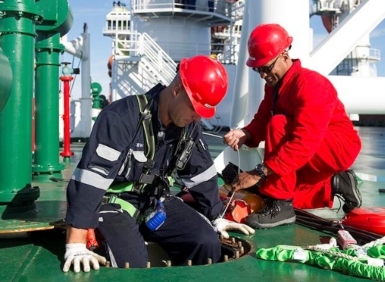 Yves Vandenborn, of the Standard Club, asks why enclosed space entry fatalities are still happening on a regular basis. This article is reprinted from the July/August edition of Maritime Risk International.
Yves Vandenborn, of the Standard Club, asks why enclosed space entry fatalities are still happening on a regular basis. This article is reprinted from the July/August edition of Maritime Risk International.
Despite the well-known risks and the numerous publications and articles available on the topic, enclosed space entry fatalities continue to account for a significant proportion of deaths at sea to date. More drastic measures are required if the industry wishes to turn this tide.
The most recent in a long list of such incidents is the death of a chief officer who entered a fumigated hold to inspect the cargo condition. In this case, detailed instructions for the fumigation of the cargo were given to the vessel clearly stating that the fumigant was potentially dangerous. Even though the chief officer checked the hold atmosphere prior to entry, unfortunately, the gas detector he used was not capable of measuring the concentration of toxic phosphine gas. Further, the confined space entry was made using only a mask, absent was the correct self-contained breathing apparatus (SCBA), leading to fatal consequences. Hence, it is vital to ensure that all possible risks are taken into consideration before one enters an enclosed space. Despite knowing the dangers and risks, and with the importance of taking appropriate precautions continually reiterated to seafarers, there remain incidents where these precautions have not been followed by the crew. A thorough investigation into these incidences, by industry bodies such as Intercargo and P&I Clubs, reveals that it is not always due to carelessness by the seafarer or a blatant disregard of the precautions. Some of these incidents include instances of ill attempted rescues of co-workers, where the crew in their urgent attempt to render aid to their co-worker, rush into enclosed spaces without proper care for themselves. These circumstances are understandably critical, but it is crucial that proper safety procedures are abided by, otherwise there will be multiple lives at risk.
There have also been a few inexplicable cases reported where crew circumvented safety procedures and entered through the access hatches, which display prominent warning signs, without proper protective gear. Many toxic gases or vapours cannot be seen or smelled, so it is vital to remember that one should never trust their senses to determine if the atmosphere is safe and instead follow correct entry procedures.
Insight into recent enclosed space-related casualties show that most incidents were caused on board dry cargo ships; and that several of such incidents were easily preventable if the necessary procedures were followed. While most of the tanker companies understand the risks concerned with enclosed spaces, the dry sector seems to be lagging. This is not limited to risks associated with enclosed spaces, but equally stretches out to cargo handling. Knowledge of the risks attributed to liquefaction, fumigation, stowage, ventilation etc is required to safely manage the wide variety of cargo that is able to be carried on dry cargo ships.
Lack of awareness, for both ship and shore personnel, is perhaps the major cause of such incidents. From the shore side, the shippers are not necessarily aware of the IMSBC or IMDG code requirements; and quite often the cargo is misdeclared. From the ship’s side, not following the relevant safety management procedures is most likely the single major contributing factor.
Under section 7 of the International Safety Management (ISM) Code, the company should ensure that the enclosed space entry procedures are included among the key shipboard operations. As of 1 January 2015, the amended SOLAS Regulation III/19 requires mandatory enclosed space entry and rescue drills to be held every two months. SOLAS Regulation XI-1/7 states a requirement for mandatory carriage of portable atmosphere testing instrument(s) from 1 July 2016. Additional guidance has also been provided through following IMO circulars:
• Revised recommendations for entering enclosed spaces aboard ships (resolution A.1050(27)); and
• Guidelines to facilitate the selection of portable atmosphere testing instruments for enclosed spaces as required by
SOLAS Regulation XI-1/7 (MSC.1/Circ.1477).
As previously mentioned, another high risk posed on dry cargo ships is regarding fumigation. Due to the current pandemic, there are more instances of crew being tasked to handle fumigant materials, as qualified fumigators are either not available or restricted to travel. This means that ship operators and crew, who do not have the necessary expertise to handle toxic materials, are exposed to a new operational environment.
SOLAS VI/4 on the use of pesticides in ships, states that “appropriate precautions shall be taken in the use of pesticides in ships, in particular for the purposes of fumigation”. IMDG and IMSBC Codes provide similar recommendations to ensure safe and effective fumigation. Further guidance related to the fumigation of cargo is laid down in the following IMO circulars:
• Revised Recommendations on the safe use of pesticides in ships (MSC.1/Circ.1358);
• Recommendations on the safe use of pesticides in ships applicable to the fumigation of cargo holds (MSC.1/Circ.1264, as amended by MSC.1/Circ.1396); and
• Revised Recommendations on the safe use of pesticides in ships applicable to the fumigation of cargo transport units
(MSC.1/Circ.1361).
Although the regulatory requirements are well laid out, and safety standards should be improving, the increasing trend of casualty statistics indicate otherwise. A review of causation reveals that the majority of casualties happened either due to a lack of awareness or poor knowledge. It is therefore vital that the training element is strengthened to improve crew awareness to ensure that they are able to identify and assess risks effectively and implement appropriate mitigating measures.
Currently, the standards of training and drills vary on each ship. Unfortunately, drills are often done as a tick-box exercise to comply with the regulatory requirements; and the crew is either not aware of the confined spaces onboard or the fact that the adjacent spaces to a confined space might be posing similar hazards. Drills need to be realistic, focused, varied, interesting, challenging; and they need to test skills, knowledge, and responses, while giving a scope to improve and develop. Crew need to take these drills seriously and they need to realise that these drills are not just
compliance requirements, but life-saving practices as they help to ensure a better response in the case of an emergency.
Likewise, training is a two-pronged approach. Alone, seafarers taking it seriously is not enough; shipping companies must also recognise the importance of training and invest in it. In terms of training, there are some companies who invest in sophisticated training and education tools, but there remains to be many that do not. Investing in training does not stop at quality tools and education methods; it extends to the execution of how it is delivered. Careful thought must be put into how these training sessions are carried out, from a systematic execution of the training courses and syllabus to the scheduled review of the seafarers understanding of what has been taught. Quality is of great importance, as no company would want their crew being oblivious to the dangers surrounding them on a daily basis.
Usually on tankers, the level of specialised training is quite detailed and crew knowledge is tested during the regular vetting inspections. There are a number of IMO model courses in place for the different types of tankers, designed for the various crew proficiency levels. Officers and crew are, therefore, well informed of the specific requirements of handling cargoes and well versed in their understanding of associated risks. This approach has, through the years, seen a reduction in the general number of enclosed space entry incidents on tankers. Unfortunately, this is not the case on dry cargo ships. The dry cargo handling courses are usually very generic in nature and do not address the specific hazards associated with various kind of dry cargoes, be it in packaged or in bulk form. Training courses and drills must be specifically tailored to a dry cargo environment for it to be effective and applicable.
 As the STCW Convention is the driving factor in crew certification and training, perhaps having a few standardised IMO model courses for dry cargo ships would assist in making seafarers aware of the risks, not just for enclosed space or fumigation, but also for other pertinent issues such as liquefaction, dynamic separation, cargo ventilation and so on.
As the STCW Convention is the driving factor in crew certification and training, perhaps having a few standardised IMO model courses for dry cargo ships would assist in making seafarers aware of the risks, not just for enclosed space or fumigation, but also for other pertinent issues such as liquefaction, dynamic separation, cargo ventilation and so on.
Yves Vandenborn (pictured right) is the Loss Prevention Director working for the Standard Club and based in Singapore.

